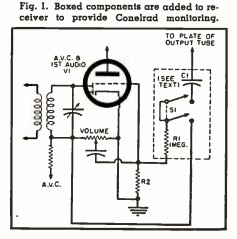 Starting in 1957, U.S. Amateur Radio operators were required to participate in CONELRAD. (If you’re unfamiliar with CONELRAD, I explain it in other posts, including this one.) Under the regulations that took effect that year, hams were required to monitor an AM broadcast station whenever transmitting. If that station went off the air, the ham was required to check to see if the absence from the air was due to a CONELRAD alert. If so, he was required to leave the air.
Starting in 1957, U.S. Amateur Radio operators were required to participate in CONELRAD. (If you’re unfamiliar with CONELRAD, I explain it in other posts, including this one.) Under the regulations that took effect that year, hams were required to monitor an AM broadcast station whenever transmitting. If that station went off the air, the ham was required to check to see if the absence from the air was due to a CONELRAD alert. If so, he was required to leave the air.
The regulations could be satisfied by keeping an AM radio on low volume in the background, but the preferred method was to have an automated alarm that would sound if an AM station left the air. One popular receiver for that purpose was the Heathkit CA-1 CONELRAD alarm, which was an external monitor that would be hooked to a receiver. Other dedicated receivers wwere available, such as the Kaar Engineering Conalert II, although a unit such as that would be out of the price range of most hams, and probably used mostly by broadcast stations.
The April, 1957, issue of Radio News carries an article entitled “Conelrad the Easy Way,” with a simple method of converting a five-tube broadcast receiver into a CONELRAD monitor. As shown in the schematic above, it required only three parts, and allowed the radio to be used for normal listening. The additions to the circuit are the three parts inside the dotted lines.
This circuit ties in to the AVC voltage of the first audio amplifier. As long as there is an AVC voltage present, the added resistor biases the first tube to silence the radio. But if the AVC voltage disappears (because there is no signal present), then the output of the final audio amplifier gets fed back to the first audio amplifier, causing the two stages to break into oscillation to emit a loud squeal.
It’s a pretty ingenious and easy modification, and the author reports that many hams were using it and that he thought “it is the answer to the Conelrad needs of most hams.” He even notes that the circuit “is so simple that many broadcast listeners may want to install it on their receivers, just in case.”
The author, by the way, is John T. Frye, W9EGV. If that name rings a bell, it is because Frye was a prolific writer in many electronics and radio magazines. He was most famous as the author of the “Carl and Jerry” stories that appeared in Popular Electronics from 1954-1964.
